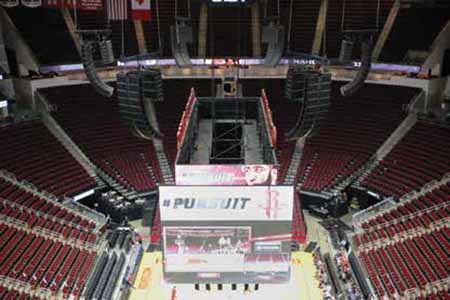How the Houston Rockets Are Doing More with Much Less

Houston Rockets’ Home Upgraded with L-Acoustics PA Rig
The implementation of the new PA rig, comprising six hangs each of 12 K2 variable curvature enclosures, together with three K1-SB subs flown behind each array, is the final step in an upgrade process that began with the installation of one of the largest center-hung HD video scoreboards in an indoor arena in the U.S. The Toyota Center, home to the NBA’s Houston Rockets, recently completed a major makeover of its installed AV systems with the addition of an L-Acoustics K2 sound system. The implementation of the new PA rig, comprising six hangs each of 12 K2 variable curvature enclosures, together with three K1-SB subs flown behind each array, is the final step in an upgrade process that began with the installation of one of the largest center-hung HD video scoreboards in an indoor arena in the U.S.
According to Kevin Broussard, sales engineer with AV systems integrator LD Systems in Houston, TX, “About two years ago they embarked upon an upgrade to their video experience.” Manufactured and installed by Panasonic, the video scoreboard measures 58 feet wide by 25 feet wide along the east and west seating areas and 25 feet square at the north and south ends. The multipurpose sports and entertainment arena, opened in October 2003, seats approximately 18,000 for basketball games and 19,000-plus for concerts.
“This past year, the objective was to improve the audio to match current technology. The ultimate goal was to give the fans the best experience,” said Broussard.
LD Systems was the vendor and integrator for the previously installed sound system, said Broussard. “So we were one of a few different people that they contacted to look at ideas and designs for the new system.”
LD Systems proposed an L-Acoustics system, having been standing behind the brand for some years now, he said. “We’ve had some pretty great success with several installations with their products, with the ability to design something within the [L-Acoustics] Soundvision software, and then actually put it into the space and have it be extremely predictable. That’s something that we love about their systems.” The design was created in partnership with L-Acoustics and project consultant WJHW.
System set-up and tuning took only one day, he reported. “Typically it’s a multi-day venture with lots of engineers and lots of ears on the system.”
A daily selection of the top stories for AV integrators, resellers and consultants. Sign up below.
The six flown arrays—two each down the east and west sides and one at each end—provide even coverage, Broussard said. A total of 29 LA8 and two LA4 amplified controllers power the system.
“With the new K2 system having a 10-degree inter-cabinet angle, we’re able to achieve a very uniform coverage from the bottom to the top of the bowl with a minimal number of boxes. One of the goals of the installation was to provide as little overlap between cabinets as possible to eliminate any kind of phasing or phase cancellation and to minimize reflections. Given that the K2 is such a high-powered box, with its now wider dispersion ability, we were able to get a very high-impact, high-SPL system with a reasonable number of boxes,” he said.

The six flown arrays—two each down the east and west sides and one at each end— provide even coverage, Broussard said. A total of 29 LA8 and two LA4 amplified controllers power the system. Six L-Acoustics ARCS Wide constant-curvature cabinets installed below the long edges of the scoreboard cover the courtside seating. “We needed the system to cut off at a certain point for events that would need ground coverage only, or seat coverage only,” explained Broussard, noting that the arena could potentially host an ice hockey team, as it has in the past. “In the typical NB A setup, you need coverage about an additional 20 feet out between the [ice hockey] dasher wall and the edge of the court. That gap is filled in very seamlessly with the ARCS Wides.”
Four L-Acoustics 12XTi coaxial speakers provide down fill below the scoreboard. “Those are mostly for either monitor support for half-time events or non-NB A use, so we have complete coverage of the entire bowl and floor. L-Acoustics’ product is well-known for its ability to match other cabinets within its lines. You have a coaxial box with a variable curvature box, and everything sounds the same, with very little EQ difference between them.”
LD Systems also helped relocate the venue’s mix position out of the old control room: “The operators are out of the bowl now, and they’re loving it.”
The system’s Speech Transmission Index (STI) measurements are above average, ranging from 0.63 to 0.75. According to Scott Foulkrod, the venue’s AV manager, “We needed to have very high intelligibility for the PA announcers, so that the fans would really understand every word, and we wanted to be able to create some good thump for music, and this system does both. The sound is clear and powerful but without having to be overbearingly loud.”
The new rig offers size, weight, and energy savings over the previously installed system. “We’re doing a lot more with much, much less,” said Broussard. “Efficiency was not necessarily a design criterion, but it was a side effect, and very beneficial to the venue. And now their weight loading has been so far reduced that they’re able to support much larger touring productions in there.”
Steve Harvey (sharvey.prosound@gmail.com) has been west coast editor for Pro Sound News since 2000 and also contributes to TV Technology, Pro Audio Review, and other NewBay titles. He has over 30 years of hands-on experience with a wide range of audio production technologies.
